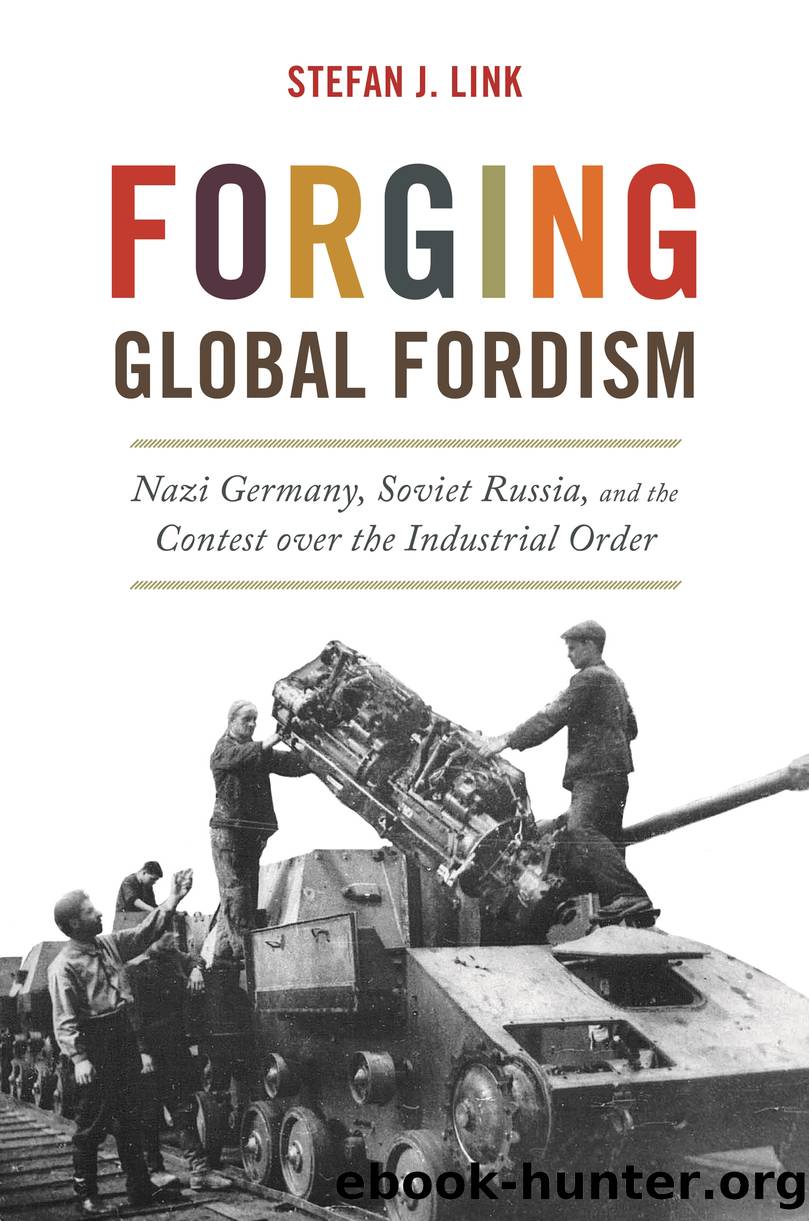Forging Global Fordism by Link Stefan J.;

Author:Link, Stefan J.;
Language: eng
Format: epub
Publisher: Princeton University Press
Published: 2020-07-15T00:00:00+00:00
Conclusion
In 1938, German consular staff in the United States decorated two prominent American businessmen with an award that the Nazi regime bestowed on foreigners who, according to the official designation, âhad been of service to the Reich.â One of the recipients was GMâs overseas chief executive James Mooney, who accepted the Order of Merit of the Cross of the German Eagle, First Class, from the German consul in New York on August 17. The other awardee was Henry Ford. In a brief ceremony at the Dearborn Laboratory, two German diplomats pinned the Grand Cross of the German Eagle, the awardâs highest rung, to Fordâs chest. The occasion was Fordâs seventy-fifth birthday on July 30. A year earlier, Thomas Watson, IBMâs chief executive, had received a similar decoration from Hjalmar Schacht at the occasion of the International Chamber of Commerceâs Berlin conference.
There were two contexts for these remarkable gestures of recognition. Mooneyâs and Fordâs awards occurred, first, as part of an effort of Nazi diplomats to strengthen pro-German voices on the American right at a time when diplomatic relations were deteriorating. Over the course of 1938, German consular staff gave more than a dozen eagle crosses to Americans. Apart from one celebrity, Charles Lindbergh, the other awardees were lesser-known figures, such as the Stanford historian Ralph Haswell Lutz and Oberlin professor Karl Geiser, the translator of Sombartâs works for Princeton University Press. Such bestowals ceased after the pogroms of November 1938 had turned American public opinion firmly against Nazi Germany.148 An equally important reason for the decorations of Watson, Mooney, and Ford was the Nazi regimeâs transnational industrial politics. The awards reflected the close, if tense and quarrelsome, relationships that American multinationals developed with the Nazi regime over the course of the Thirties. Watson received his decoration for âbettering economic relations,â as the New York Times reported; Mooney his âin recognition of his services in the development of the Adam Opel AG in Germany,â as American military officials later concluded.149
Connections such as these have prompted historians to ask questions about complicity. Did American businesspeople sympathize with the Nazi agenda? Did their firms collude with the Nazi regime? Were there alternative courses of action they chose to forgo? Though these questions remain urgent, this chapter has adopted a different angle: we asked how the Nazi regime managed to rope the powerful American carmakers into serving the needs of motorization and rearmament in the first place.
It turns out there was a certain method to the madness. The regime subjected Ford and GM to the general line of economic steering. The framework mechanism was capital controls. By refusing to allocate foreign exchange, the authorities pushed GM and Ford to support the exports of their German branches and to provide them with crucial raw materials against barter or book debits. The branches also acquired American machine tools without taxing the Nazi hard currency coffers. Since Ford and GM were debarred from repatriating profits, they recycled earnings into plant, machinery, and other fixed investments. Thus GMâs
Download
This site does not store any files on its server. We only index and link to content provided by other sites. Please contact the content providers to delete copyright contents if any and email us, we'll remove relevant links or contents immediately.
International Integration of the Brazilian Economy by Elias C. Grivoyannis(91483)
The Radium Girls by Kate Moore(11927)
Turbulence by E. J. Noyes(7940)
Nudge - Improving Decisions about Health, Wealth, and Happiness by Thaler Sunstein(7622)
The Black Swan by Nassim Nicholas Taleb(7016)
Rich Dad Poor Dad by Robert T. Kiyosaki(6413)
Pioneering Portfolio Management by David F. Swensen(6229)
Man-made Catastrophes and Risk Information Concealment by Dmitry Chernov & Didier Sornette(5924)
Zero to One by Peter Thiel(5690)
Secrecy World by Jake Bernstein(4651)
Millionaire: The Philanderer, Gambler, and Duelist Who Invented Modern Finance by Janet Gleeson(4382)
The Age of Surveillance Capitalism by Shoshana Zuboff(4214)
Skin in the Game by Nassim Nicholas Taleb(4165)
Bullshit Jobs by David Graeber(4100)
The Money Culture by Michael Lewis(4082)
Skin in the Game: Hidden Asymmetries in Daily Life by Nassim Nicholas Taleb(3935)
The Dhandho Investor by Mohnish Pabrai(3704)
The Wisdom of Finance by Mihir Desai(3658)
Blockchain Basics by Daniel Drescher(3511)
